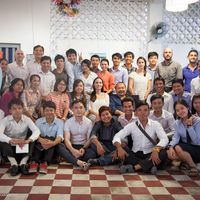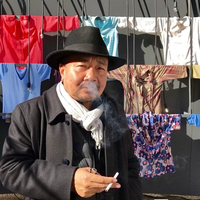Cannes 2005 - ASEM Films Co-Production Supported
A movie theatre in Seoul is the starting point for Hong Sangsoo latest film “TALE OF CINEMA”. From there, the plot surfs into the destinies of two men and a young woman whose common interest is their love for films and movie theatres.
The story is developed on different layers. Hong Sangsoo said that his film might be about a movie theatre show. But, on the second level it is the characters behaviours and their permanent adolescence that appear to be the most important element of the film.
Asking the Korean filmmaker about his way of conceiving movies, Hong says that he generally starts writing from ordinary situations gathered around him – very simple stories. Most of the time, these situations are not related. The director then tries to find a pattern to unite these stories. This is how he conceived his “WOMAN IS THE FUTURE OF MAN” presented last year in Cannes. The filmmaker used the same way of working for “TALE OF CINEMA” which was this year in competition for the “PALME D’OR”.
"THE BURNED THEATRE" by Rithy Panh (Cambodia) is another ASEM film presented at the 2005 edition of the Cannes International Film Festival in the Out-of-Competition Official Selection. Rithy Panh is a “habitué” of the Festival. He first came to Cannes in 1994 to present “NEAK SRE” in competition. He then presented “UN SOIR APRÈS LA GUERRE” in the Un Certain Regard selection in 1998, and in 2003 with “S21, THE KHMER ROUGE DEATH MACHINE” also presented out of competition.
As for the Korean film, the background set, and first story layer is a theatre. On the upper level the theatre is a metaphor that represents the Cambodian “Nation’s collective imagination in all its purity” The documentary film describes the life of dancers, singers, and actors in Cambodia, and the dark perspectives for a country whose traditional arts are in danger of extinction.
Cambodia is a land of broken dreams where cinemas, theatre, and playhouses have disappeared. The traditional performing arts are left aside “Soon, people won't even know what theatre is about, they'll only be watching ghost films”, he said.
Rithy Panh described the purpose of his film in three points.
- To induce people to think about the artist's role
- To induce people to think about the function of imagination
- To induce people to think about the usefulness of art.
The Cambodian filmmaker would like to underline the importance of these questions when people are “confronted to loss of memory and the ruthless scheme of short-term economic profitability”.
The very serious concern of Rithy Panh translated into images in "THE BURNT THEATRE" has something more to share with the Korean film. The story backgrounds are theatres, the filmmakers are form ASEM Asian countries and finally, they have enjoyed a similar European Television source of funding for their movies.
The two films are among the 20 selected projects out of 500 that have been submitted last year for co-production funding to ARTE - The Franco-German channel.
Each year, a committee retains 20 projects from around the world for co-production deals. The amount of the investments goes between 50 000 and 500 000 euros. ARTE co-produces features, documentary and, shorts films. Asian filmmakers such as the Chinese Sijie Dai “TANG THE 11TH”, and the Vietnamese Anh Hung TRAN “A LA VERTICALE DE L’ETE” have already benefit from the co-production investment of the Channel.
This year, not less than 18 films presented in the different categories of the Cannes Film Festival have been co-produced by the French-German TV channel. The French-German channel also co-produced the Cannes 2005 winning award film of the Belgian Dardenne brothers “L’Enfant”.
In order to submit a project to the channel, a prerequisite is for ASEM filmmakers to have a French associated producer (Find more in the Resource Directory).
French and German speakers will find more about the ARTE co-production unit here.
Similar content
posted on
22 Aug 2013
posted on
04 Sep 2015
By Kerrine Goh
25 Jun 2007
from - to
29 Aug 2018 - 08 Sep 2018
posted on
20 Mar 2017
By Kerrine Goh
08 Jul 2007




